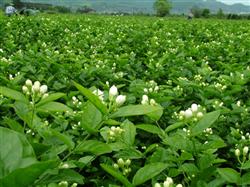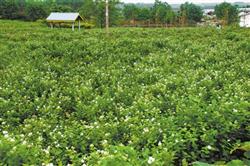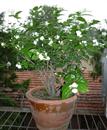How can jasmine planting be high-yielding?

How can jasmine planting be high-yielding? Please guide jasmine planting to be high-yielding can refer to the following methods: 1. Reasonable close planting. It is suitable to choose sandy loam which is convenient for drainage and irrigation and fertile. The soil is deeply ploughed and prepared into a turtle-back-shaped bed 1.3m wide. Planting row distance 65cm, acupoint distance 33cm, acupoint depth 25cm. Soil fertilizer 3000kg and superphosphate 25kg were applied per 667m2 as base fertilizer for cave bottom. There are 3 plants in each hole, and the distance between the plants is 10cm, which is triangular. About 10 000 plants were planted per fi67m2. After planting, the soil was compacted, the border was covered, and the seedlings were watered thoroughly. 2. Timely ploughing. The soil was ploughed at the depth of 7-8cm in March, May and July every year, and the root system was not damaged as far as possible. The furrow soil was cultivated at the base of the stem and the soil was thick 3cm. 3. Fertilize frequently. The withered branches were removed during the first intertillage in late March, and 600kg rare manure and urine were applied per 667m2 to promote rooting and shoots, and make them blossom ahead of time. The period from June to July is the full bloom of jasmine, which needs the most fertilizer. After picking flowers in June, the second mid-tillage was carried out, and urea 10kg was applied per 667m2, and leaves were picked to facilitate ventilation, reduce diseases and insect pests, concentrate nutrients to supply flower buds and promote more flowering in July. After the peak flowering of jasmine in July, topdressing once a month, urea 5kg/667m2 was applied each time to increase the pregnant buds and improve the quality of flowers, and 0.5% urea liquid root topdressing was used for 3-4 times in the evening. 4. Timely drainage and irrigation. The jasmine tree should keep the soil moist after survival, and the stagnant water in the field should be drained in time. In case of continuous drought, it should be irrigated or irrigated in the evening, and the border should be drained immediately after the border is moist. If the jasmine plant is soaked in water for too long, it will affect the quality of the flower and reduce the yield. 5. Topping and thinning leaves. After entering the full flowering stage, the flowers with luxuriant leaves should be topped and thinned several times to promote the gestation of more buds. Try not to leave a pedicel on topping, so as not to affect the second round of shoot germination. Flowers with many branches and luxuriant leaves should be heavily thinned, generally leaving 1 beat and 2 leaves; sparse leaves should be sparse, and withered branches and diseased leaves should be removed in time. Pay attention to protecting petioles and axillary buds when thinning leaves. By topping and thinning leaves, the yield can be increased by 10%. 6. prevention and control of diseases and insect pests. Jasmine flowers are mainly damaged by brown spot, white silk disease and scale insects. Brown spot occurs from May to October, which mainly harms the twigs and leaves and causes the branches to die. When you get sick, you should cut off the diseased branches and burn them in time, and then spray the branches and leaves with 800 times carbendazim or topiramate. White silk disease often occurs from June to July, usually begins at the base of the stem near the ground, and then gradually spreads to form a layer of white silk film. Diseased leaves often wither and fall off, and pruning dies in severe cases. At the time of onset, 75% chloronitrobenzene 2-2.5kg was used per 667m2, mixed with fine sand and spread evenly. When the scale insect occurs, it can be sprayed with 60 times oil emulsion to spray branches, leaves or kill manually. 7. Timely harvest. Jasmine florescence is very long, from June to October. It is generally divided into three stages: the first phase is in June, commonly known as "fog flowers", during which the temperature is not high and the light is poor, so the quality of flowers is poor and the output is not high. This batch of flowers should be picked in time, which is the key to ensure more flowers and good quality in the future. The method is to pick the twigs from the flowers, germinate the axillary buds into flower branches, and the second stage flowers can be picked after 3-4 weeks. The second period of flowers is from July to August, commonly known as "Fu Hua", this batch of flowers are large and long-lasting fragrance, the number is also large. The third period is from September to October, commonly known as "autumn flowers". During this period, the temperature is high and the quality of flowers is better. Click to get more jasmine planting techniques click to get more flower planting techniques
- Prev

How to manage the florescence of jasmine?
How to manage the florescence of jasmine? Please introduce and guide the jasmine to blossom one after another from the early summer. If managed properly, there may be three periods of blooming. In early June, jasmine blossoms early one after another, but these flowers are generally small and small, so they should be picked in time, otherwise too much nutrients will be consumed, which will affect the quality and quantity of their later flowering.
- Next

How to raise jasmine in the family?
How to raise jasmine in the family? Jasmine is a perennial flower of Oleaceae, which is adaptable, easy to manage and has a long flowering period. it is especially suitable for family planting. There are two common flowers: single flower and double flower. Although the single flower is not as good-looking as the double flower, it has a strong fragrance and is easy to take root. From June to November.
Related
- Fuxing push coffee new agricultural production and marketing class: lack of small-scale processing plants
- Jujube rice field leisure farm deep ploughing Yilan for five years to create a space for organic food and play
- Nongyu Farm-A trial of organic papaya for brave women with advanced technology
- Four points for attention in the prevention and control of diseases and insect pests of edible fungi
- How to add nutrient solution to Edible Fungi
- Is there any good way to control edible fungus mites?
- Open Inoculation Technology of Edible Fungi
- Is there any clever way to use fertilizer for edible fungus in winter?
- What agents are used to kill the pathogens of edible fungi in the mushroom shed?
- Rapid drying of Edible Fungi

